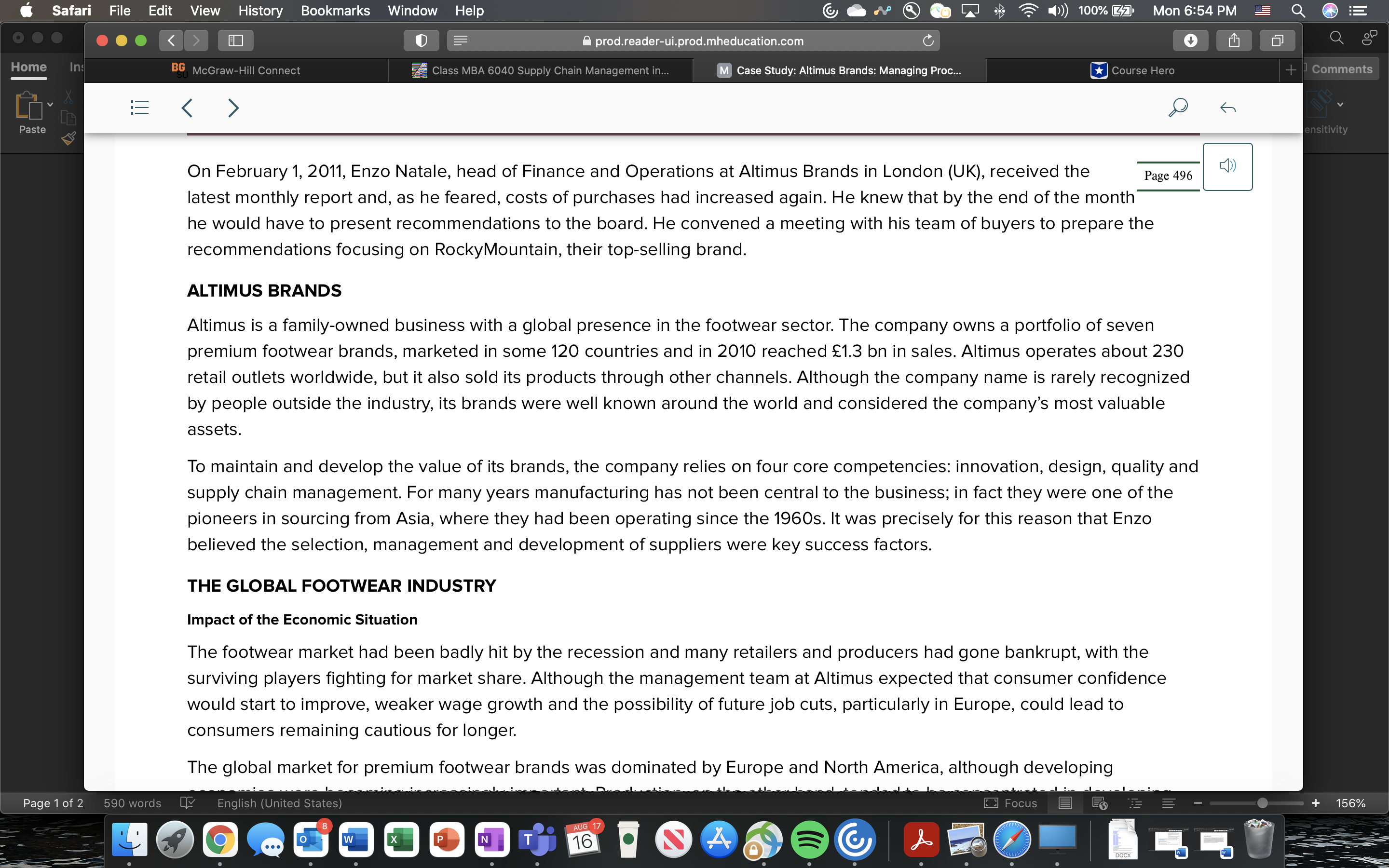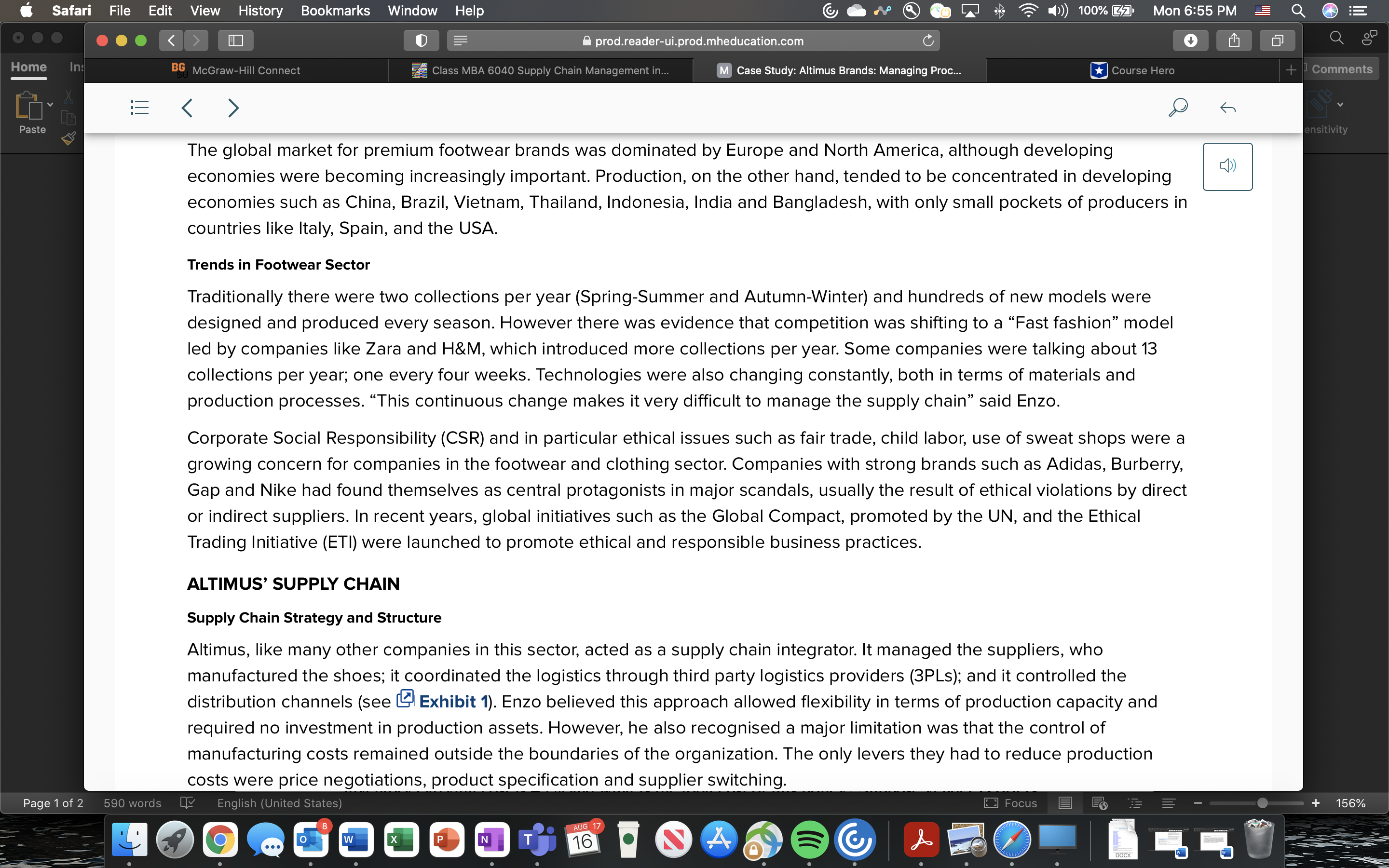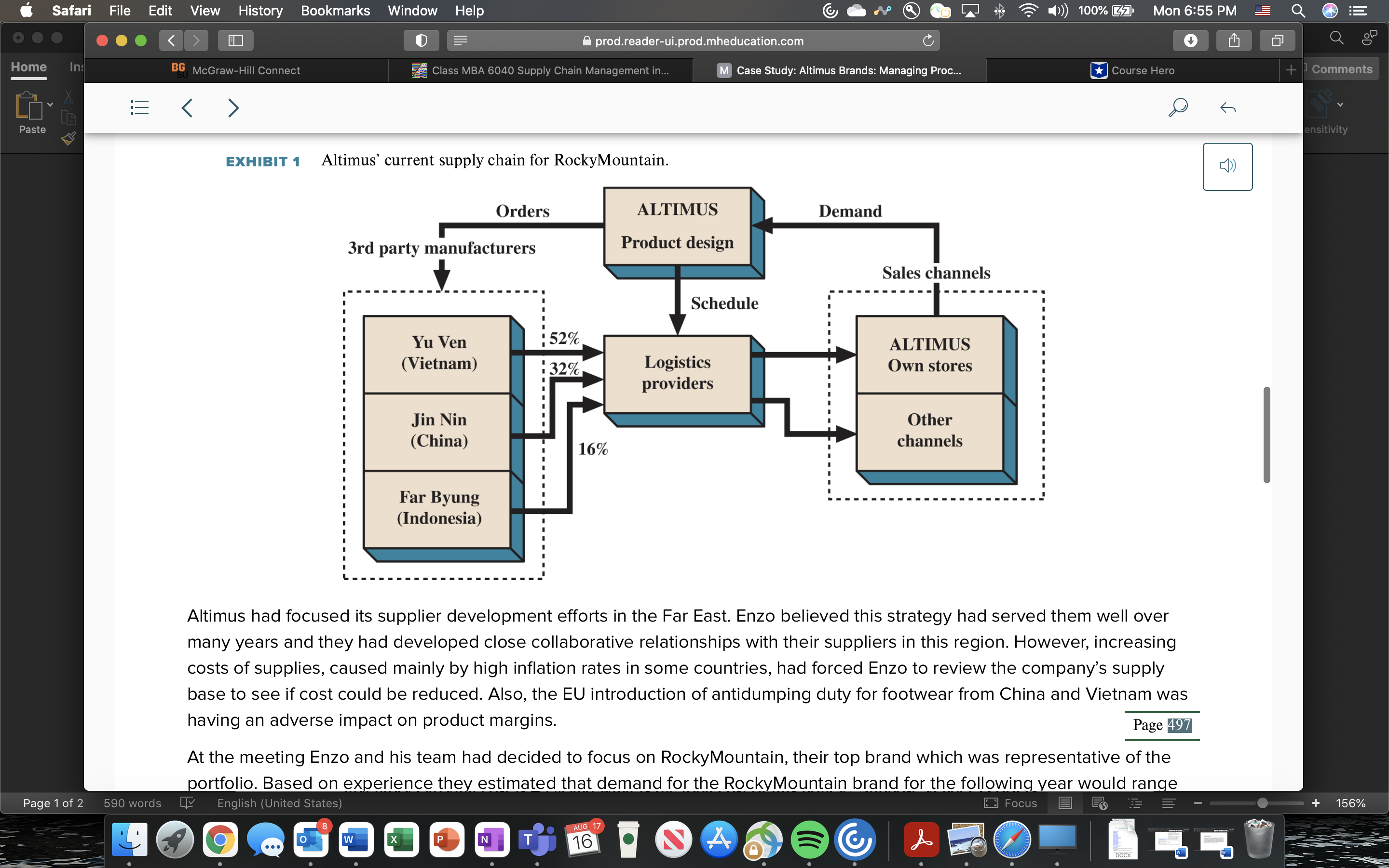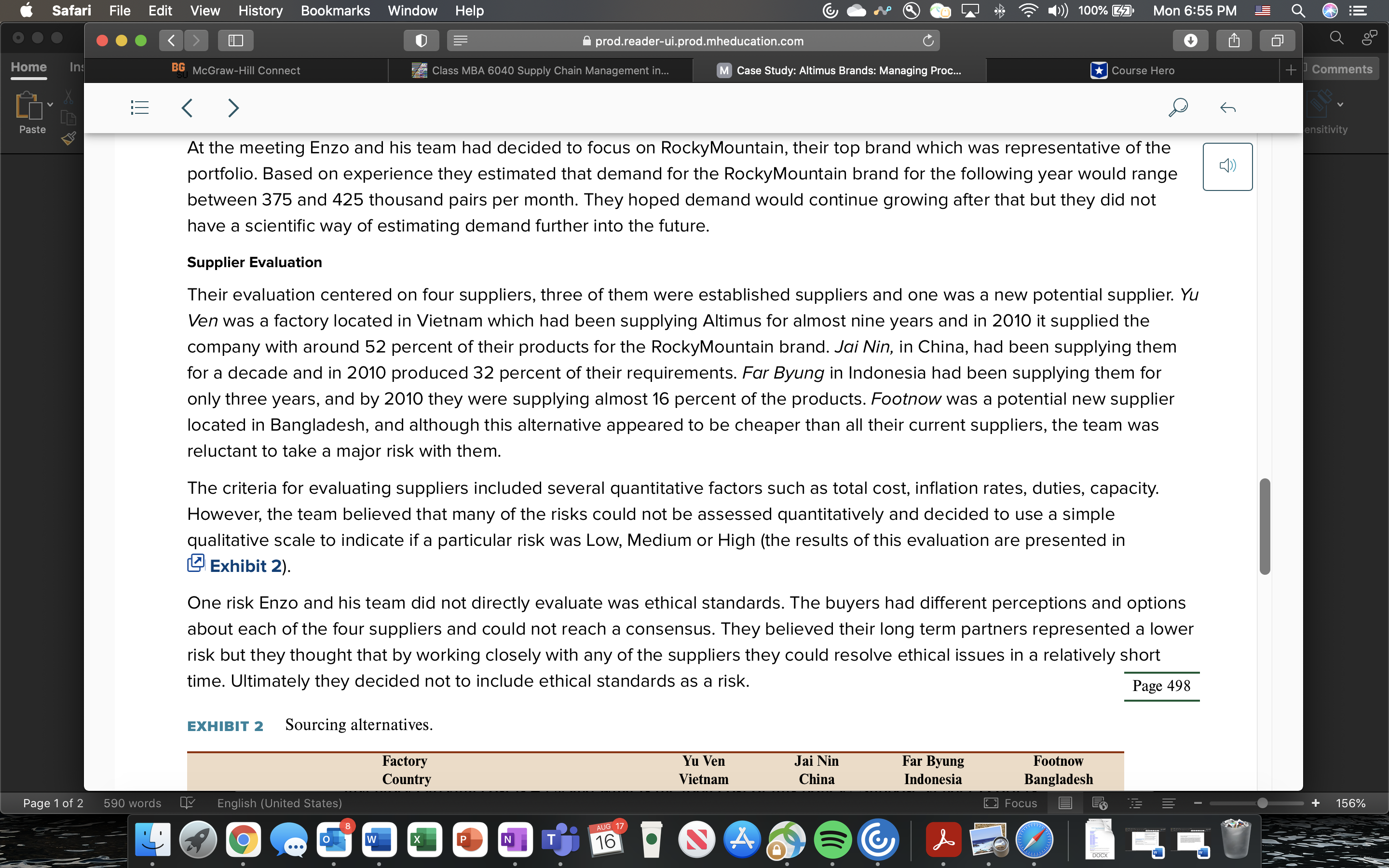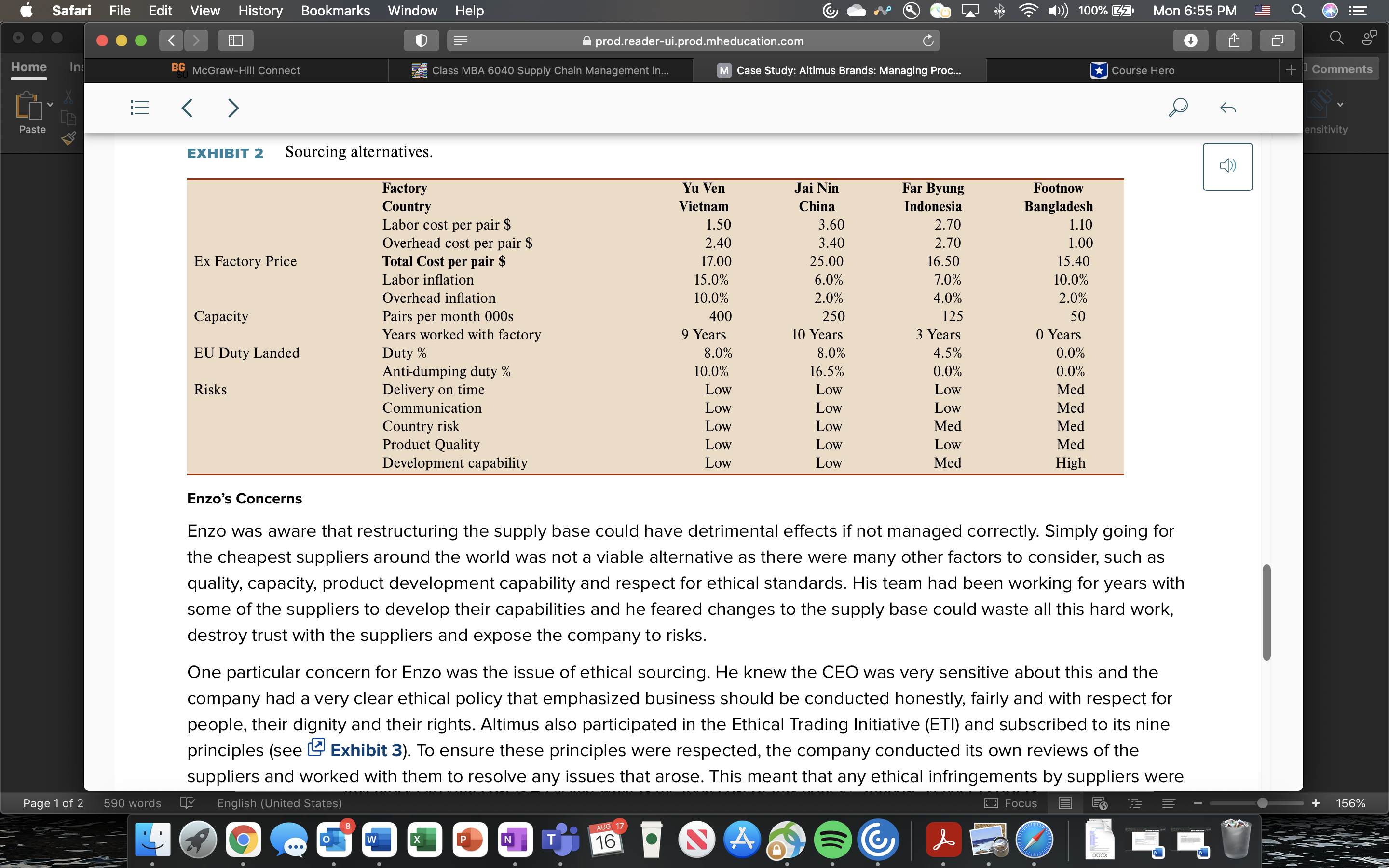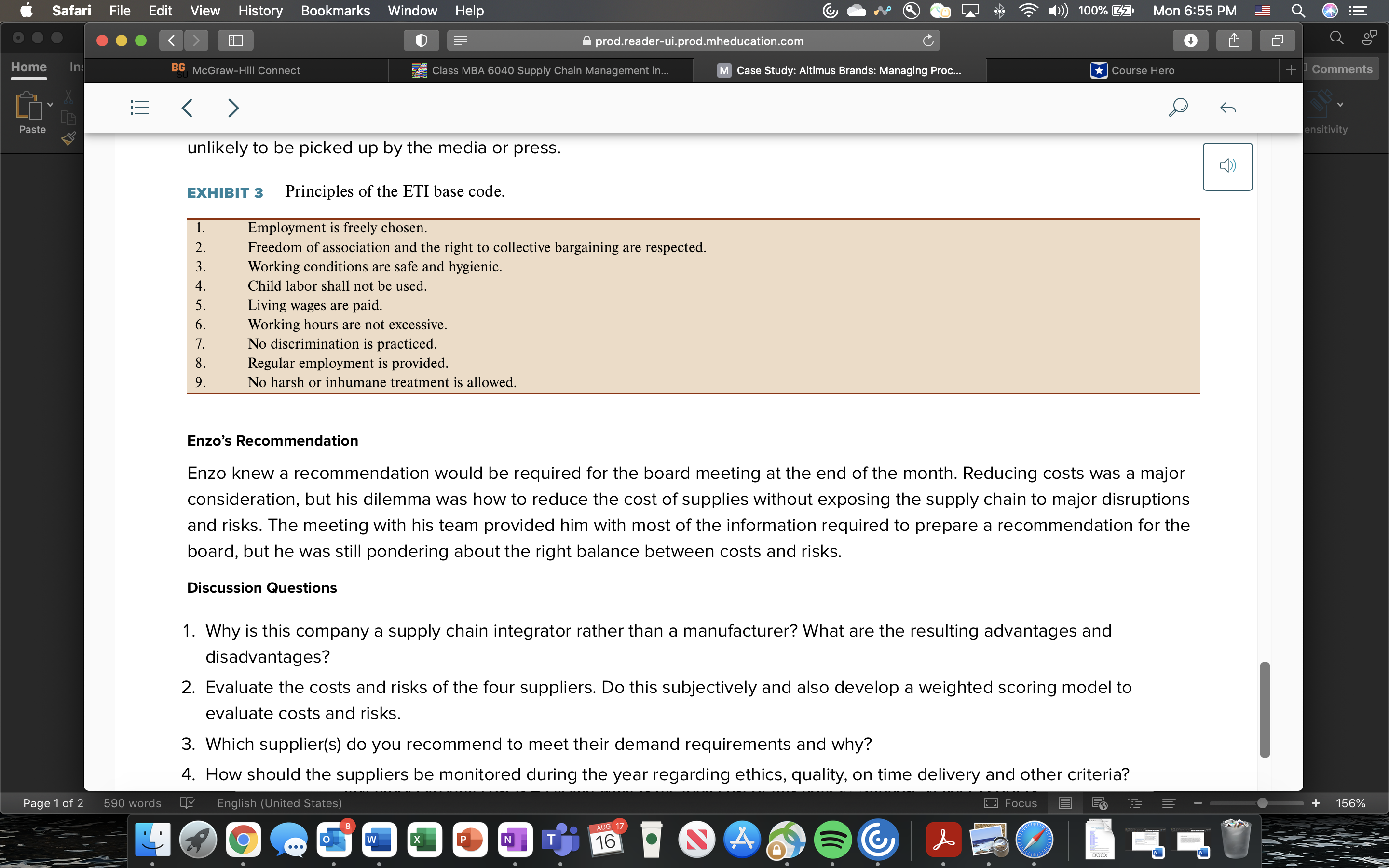I' Safari File Edit View History Bookmarks Window Help -u\" (9 . Q . 4)))100%E@r Mon 6:54PM Q E] E prod.reader-ui.prod.mheducation.com C 0 a M Case Study: Altimus Brands: Managing Proc,., E p 6 On February 1, 2011, Enzo Natale, head of Finance and Operations at Altimus Brands in London (UK), received the page 496 latest monthly report and, as he feared, costs of purchases had increased again. He knew that by the end of the month he would have to present recommendations to the board. He convened a meeting with his team of buyers to prepare the recommendations focusing on RockyMountain, their top-selling brand. ALTIMUS BRANDS Altimus is a familyowned business with a global presence in the footwear sector. The company owns a portfolio of seven premium footwear brands, marketed in some 120 countries and in 2010 reached 13 bn in sales. Altimus operates about 230 retail outlets worldwide, but it also sold its products through other channels. Although the company name is rarely recognized by people outside the industry, its brands were well known around the world and considered the company's most valuable assets. To maintain and develop the value of its brands, the company relies on four core competencies: innovation, design, quality and supply chain management. For many years manufacturing has not been central to the business; in fact they were one of the pioneers in sourcing from Asia, where they had been operating since the 1960s. It was precisely for this reason that Enzo believed the selection, management and development of suppliers were key success factors, THE GLOBAL FOOTWEAR INDUSTRY Impact of the Economic Situation The footwear market had been badly hit by the recession and many retailers and producers had gone bankrupt, with the surviving players ghting for market share. Although the management team at Altimus expected that consumer condence would start to improve, weaker wage growth and the possibility of future job cuts, particularly in Europe, could lead to consumers remaining cautious for longer. The global market for premium footwear brands was dominated by Europe and North America, although developing Page 1 Ci a 1cm sci-nod ibit The global market for premium footwear brands was dominated by Europe and North America, although developing economies were becoming increasingly important. Production, on the other hand, tended to be concentrated in developing economies such as China, Brazil, Vietnam, Thailand, Indonesia, India and Bangladesh, with only small pockets of producers in countries like Italy, Spain, and the USA. O A prod.reader-ui.prod.mheducation.com Home In: BG McGraw-Hill Connect Class MBA 6040 Supply Chain Management in... M Case Study: Altimus Brands: Managing Proc... Course Hero + Comments O Paste nsitivity EXHIBIT 1 Altimus' current supply chain for RockyMountain. () ) Orders ALTIMUS Demand 3rd party manufacturers Product design Sales channels Schedule Yu Ven : 52% ALTIMUS (Vietnam) : 32% Logistics Own stores providers Jin Nin Other (China) 16% channels Far Byung (Indonesia) Altimus had focused its supplier development efforts in the Far East. Enzo believed this strategy had served them well over many years and they had developed close collaborative relationships with their suppliers in this region. However, increasing costs of supplies, caused mainly by high inflation rates in some countries, had forced Enzo to review the company's supply base to see if cost could be reduced. Also, the EU introduction of antidumping duty for footwear from China and Vietnam was having an adverse impact on product margins. Page 497 At the meeting Enzo and his team had decided to focus on RockyMountain, their top brand which was representative of the portfolio. Based on experience they estimated that demand for the RockyMountain brand for the following year would range Page 1 of 2 590 words English (United States) Focus E + 156% AUG 17 L' 16 4 Co LoI' Safari File Edit View History Bookmarks Window Help -u\" (9 . Q \"3 4)))100%E+j Mon 6:55 PM i At the meeting Enzo and his team had decided to focus on RockyMountain, their top brand which was representative ofthe portfolio. Based on experience they estimated that demand for the RockyMountain brand for the following year would range between 375 and 425 thousand pairs per month. They hoped demand would continue growing after that but they did not have a scientic way of estimating demand further into the future. d Supplier Evaluation Their evaluation centered on four suppliers, three of them were established suppliers and one was a new potential supplier. Yu Ven was a factory located in Vietnam which had been supplying Altimus for almost nine years and in 2010 it supplied the company with around 52 percent of their products for the RockyMountain brand. JaiNin, in China, had been supplying them for a decade and in 2010 produced 32 percent of their requirements. For Byung in Indonesia had been supplying them for only three years, and by 2010 they were supplying almost 16 percent of the products. Footnow was a potential new supplier located in Bangladesh, and although this alternative appeared to be cheaper than all their current suppliers, the team was reluctant to take a major risk with them. The criteria for evaluating suppliers included several quantitative factors such as total cost, inflation rates, duties, capacity. However, the team believed that many of the risks could not be assessed quantitatively and decided to use a simple qualitative scale to indicate ifa particular risk was Low, Medium or High (the results ofthis evaluation are presented in Exhibit 2). One risk Enzo and his team did not directly evaluate was ethical standards. The buyers had different perceptions and options about each of the four suppliers and could not reach a consensus. They believed their long term partners represented a lower risk but they thought that by working closely with any of the suppliers they could resolve ethical issues in a relatively short time. Ultimately they decided not to include ethical standards as a risk. W EXHIBIT 2 Sourcing alternatives. Factory Footnow Country Bangladesh lm oIIOElT @USA', (Cy %@.. \"gm Page 'l at a I' Safari Page '1 at a File Edit View History Bookmarks Window (9 O n\" . Q \"3 I10) 100%E'rjr Mon 6:55 PM . EXHIBIT 2 Sourcing alternatives. Factory ' ' Footnow Country ' Bangladesh Labor cost per pair $ . 1.10 Overhead cost per pair 31 . 1.00 Ex Factory Price Total Cost per pair $ . 15.40 Labor ination . 10.0% Overhead ination . 2.0% Capacity Pairs per month 000s 50 Years worked with factory 0 Years EU Duty Landed Duty % . 0.0% Antidumping duty % . 0.0% Risks Delivery on time Med Communication Med Country risk Med Product Quality Med Development apability High Enzo's Concerns Enzo was aware that restructuring the supply base could have detrimental effects if not managed correctly. Simply going for the cheapest suppliers around the world was not a viable alternative as there were many other factors to consider, such as quality, capacity, product development capability and respect for ethical standards. His team had been working for years with some of the suppliers to develop their capabilities and he feared changes to the supply base could waste all this hard work, destroy trust with the suppliers and expose the company to risks. One particular concern for Enzo was the issue of ethical sourcing. He knew the CEO was very sensitive about this and the company had a very clear ethical policy that emphasized business should be conducted honestly, fairly and with respect for people, their dignity and their rights. Altimus also participated in the Ethical Trading Initiative (ETI) and subscribed to its nine principles (see .1 Exhibit 3). To ensure these principles were respected, the company conducted its own reviews ofthe suppliers and worked with them to resolve any issues that arose. This meant that any ethical infringements by suppliers were im- IIOElT augag, lac. uh I' Safari File Edit View History Bookmarks Window Help (Cy -u\" (9 . Q \"3 4)))100%E@r Mon 6:55 PM .
